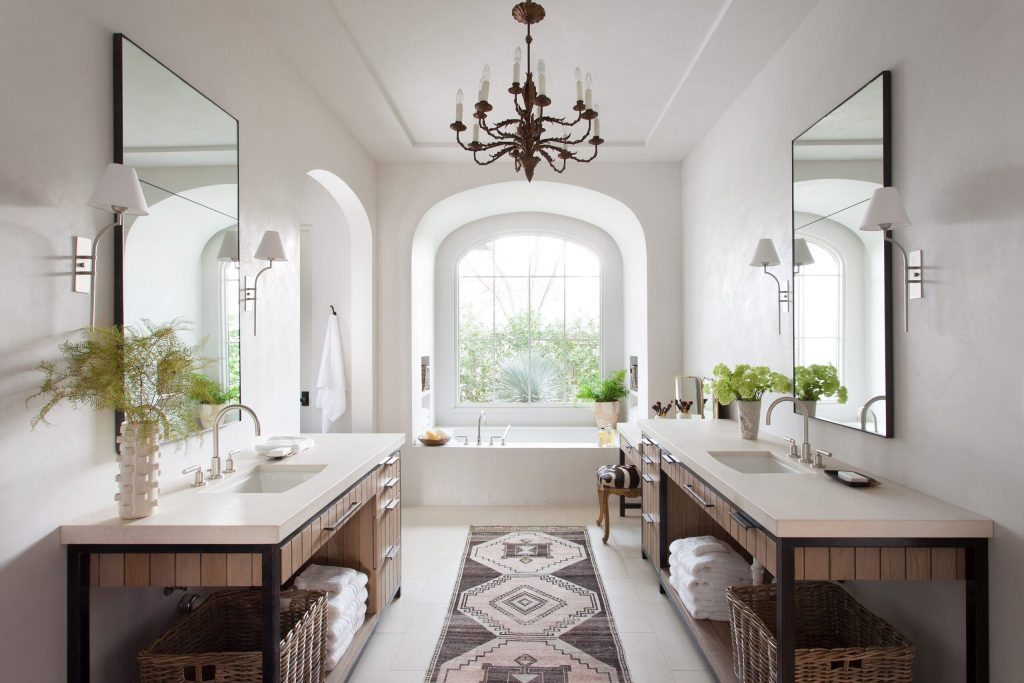Everything to Know About Bathroom Chandeliers

Chandeliers aren’t just for dining rooms and foyers anymore. These decorative light fixtures, suspended from the ceiling by a chain or tube, can bring a touch of luxury and style to your bathroom, as well.
With options ranging from fancy crystal designs to sleek modern ones, bathroom chandeliers can transform your space into a sophisticated retreat. In this guide, we’ll outline everything you need to know about choosing, installing, and maintaining the perfect chandelier for your bathroom.
Bathroom Chandelier Basics
A bathroom chandelier is a decorative lighting fixture designed to withstand the unique conditions of a bathroom environment. Unlike traditional chandeliers, these fixtures are specially crafted to resist moisture and provide adequate lighting in smaller spaces.
Bathroom chandeliers come in various sizes, from mini models suitable for powder rooms to larger statement pieces for spacious master baths.
How To Determine the Proper Bathroom Chandelier Size
The size of your chandelier should be proportionate to your bathroom’s dimensions. A general rule of thumb is to add the length and width of the room in feet and convert that sum to inches to determine the ideal chandelier diameter. For example, in a 10-foot by 12-foot bathroom, a chandelier with a diameter of about 22 inches would be appropriate. However, in bathrooms, it’s often best to err on the smaller side to avoid taking over the space.
The height of the ceiling is another key factor in choosing a chandelier for the bathroom. Generally speaking, the bottom of a chandelier should hang at least seven and a half feet above an open floor — but more stringent additional standards apply in the bath. For residential electrical safety, electrical codes typically require bathroom light fixtures, fans, or vents to be at least 8 feet above the tub or 3 feet away from it.
Popular Bathroom Chandelier Styles
Bathroom chandeliers come in various styles to fit different style preferences:
- Traditional: Curved branches extend from a central base, often adorned with crystal drops.
- Drum: Enclosed light source within a cylindrical shade, offering a softer glow.
- Tiered: Multiple frames descending in size, creating a dramatic cascading effect.
- Starburst: Straight branches extending from a central point for a modern look.
- Mini chandeliers: Compact versions ideal for smaller bathrooms or powder rooms.
Matching Your Chandelier To Your Bathroom Decor
When picking a chandelier, consider the existing elements in your bathroom. The fixture should complement other light sources, faucets, and hardware finishes. While mixing materials can create an interesting contrast, avoid stark differences that might clash. For instance, a crystal chandelier might look out of place in a sleek, modern bathroom. Consider the overall theme of your space and choose a chandelier that enhances rather than detracts from it.
Safety Considerations for Bathroom Chandeliers
Safety is most important when installing any electrical fixture in a bathroom. Here are key factors to keep in mind:
Electrical Safety Requirements for Bathroom Chandeliers
Bathroom chandeliers must meet specific electrical safety standards. According to electrical codes, any bathroom light fixture must be connected to a wall switch for safe operation. Dimmer switches, while tempting, are not recommended for bathroom chandeliers due to safety concerns in wet environments.
Moisture Resistance and IP Ratings of Chandeliers
When shopping for a bathroom chandelier, look for fixtures rated for damp or wet locations. The Ingress Protection (IP) rating indicates how well a fixture is sealed against moisture and dust. Check local codes for the appropriate IP rating required in your area to ensure your chandelier can withstand bathroom conditions.
Chandelier Height and Placement Guidelines
Proper placement is crucial for both safety and aesthetics. The NEC stipulates that any bathroom light fixture must be at least eight feet above the tub or three feet away from it. Generally, the bottom of a chandelier should hang at least seven and a half feet above an open floor to prevent accidents and provide adequate clearance.
Where To Place Your Bathroom Chandelier
Placement is key to making sure your chandelier is easy to use and doesn’t engulf your bathroom space.
In many cases, installing the chandelier in the center of the room provides the best balance, especially if you have a tub, shower, and vanity along the walls. This placement helps distribute light evenly throughout the space. However, keep those electrical codes in mind and don’t place the chandelier too close to the tub.
If your bathroom features a freestanding tub, consider hanging the chandelier directly above it. This placement adds a touch of luxury to your bathing experience. Make sure the chandelier is high enough to meet safety requirements while maintaining the ambiance you want.
Lighting Considerations for Bathroom Chandeliers
Proper lighting is essential in a bathroom, and your chandelier will play a central role.
Chandelier Bulb Types and Brightness
Choose bulbs that provide enough brightness for your bathroom activities while creating the desired atmosphere. LED bulbs are energy-efficient and long-lasting, making them a good choice for bathroom chandeliers. Consider bulbs with adjustable color temperatures for task lighting and relaxation.
Incorporating Dimmers and Controls on Bathroom Light Switch
While dimmer switches directly on the chandelier are not recommended for safety reasons, you can install a dimmer switch on the wall to control the chandelier’s brightness. This allows you to adjust the lighting for different times of day or activities, enhancing the versatility of your lighting.
Complementing Other Bathroom Light Sources
Your chandelier should work with other light sources in the bathroom, such as pendant lights or vanity sconces. Make sure the combined lighting is bright enough for grooming tasks while still contributing to the atmosphere. Consider layering your bathroom lighting to achieve the perfect balance of task and ambiance.
Installation Tips and Best Practices for a Bathroom Chandelier
Proper installation is necessary for your safety and the performance of your bathroom chandelier. Explore our dos and don’ts guide for further information about bathroom chandelier lighting installation.
Hiring a Professional vs. DIY Chandelier Installation
While some homeowners may feel confident installing a chandelier themselves, hiring a professional electrician is typically the safest choice for bathroom installations. Professionals can confirm that all electrical and safety codes are met and that the fixture is properly secured and waterproofed.
Tools and Materials Needed
If you decide to install the chandelier yourself, you’ll need:
- Electrical tape
- Ladder or step stool
- Wire strippers
- Screwdrivers
- Voltage tester
- Wire nuts
- Mounting bracket
Step-by-Step Bathroom Chandelier Installation Process
- Turn off power to the circuit at the breaker box.
- Remove the existing fixture, if any.
- Install the mounting bracket according to the manufacturer’s instructions.
- Connect the wires, matching black to black, white to white, and ground to ground.
- Secure the canopy to the ceiling.
- Attach the chandelier to the mounting bracket.
- Install bulbs and any decorative elements.
- Turn the power back on and test the fixture.
Always follow the manufacturer’s instructions and local electrical codes during installation.
Maintaining Your Bathroom Chandelier
Proper maintenance will keep your bathroom chandelier looking beautiful and working safely for years.
Chandelier Cleaning and Care Tips
Regular cleaning is necessary to maintain the beauty of your bathroom chandelier:
- Dust the fixture weekly with a soft, dry cloth.
- For deeper cleaning, use a mild soap solution and a damp cloth, being careful not to let water drip into electrical components.
- Clean crystal elements with a mixture of one part isopropyl alcohol to three parts distilled water.
- Always ensure the chandelier is completely dry before turning it on.
When To Replace Parts or Upgrade Your Bathroom Chandelier
Inspect your chandelier regularly for signs of wear or damage. Replace frayed wires, cracked sockets, or damaged crystals immediately. If your chandelier no longer meets your style preferences or lighting needs, consider upgrading to a new fixture that suits your current bathroom design.
Our Conclusion
Bathroom chandeliers offer a unique opportunity to blend elegance and functionality in your space. By carefully considering size, style, safety requirements, and placement, you can find a chandelier that illuminates your bathroom and elevates its overall design. Remember to prioritize safety in both selection and installation and don’t hesitate to consult with professionals for the best results.
Whether you opt for a traditional crystal design or a modern minimalist piece, a bathroom chandelier can transform your daily routines into luxurious experiences. With proper care and maintenance, your chandelier will continue to be a stunning focal point in your bathroom for years to come.







